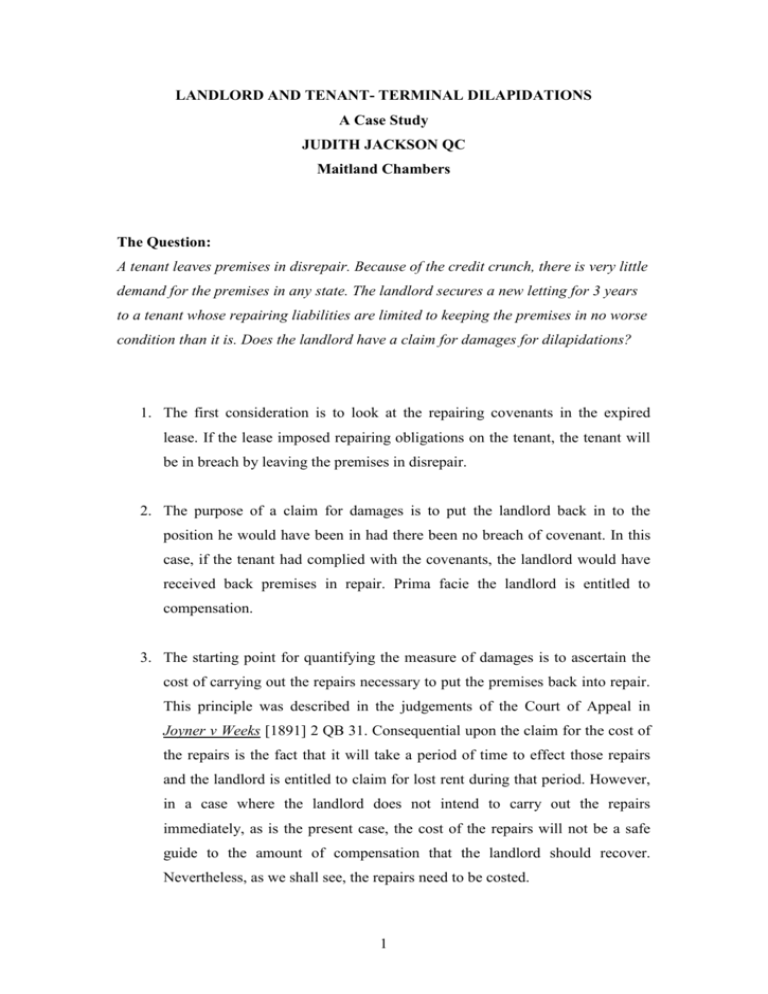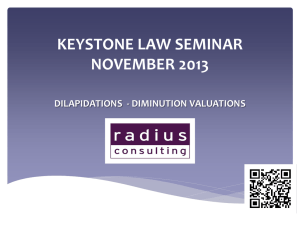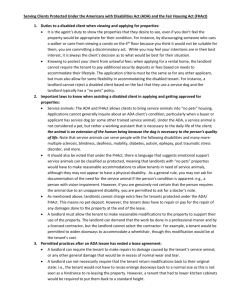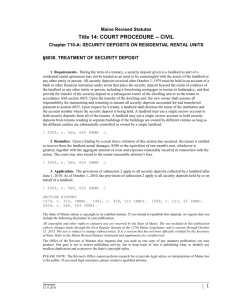A tenant leaves premises in disrepair
advertisement

LANDLORD AND TENANT- TERMINAL DILAPIDATIONS A Case Study JUDITH JACKSON QC Maitland Chambers The Question: A tenant leaves premises in disrepair. Because of the credit crunch, there is very little demand for the premises in any state. The landlord secures a new letting for 3 years to a tenant whose repairing liabilities are limited to keeping the premises in no worse condition than it is. Does the landlord have a claim for damages for dilapidations? 1. The first consideration is to look at the repairing covenants in the expired lease. If the lease imposed repairing obligations on the tenant, the tenant will be in breach by leaving the premises in disrepair. 2. The purpose of a claim for damages is to put the landlord back in to the position he would have been in had there been no breach of covenant. In this case, if the tenant had complied with the covenants, the landlord would have received back premises in repair. Prima facie the landlord is entitled to compensation. 3. The starting point for quantifying the measure of damages is to ascertain the cost of carrying out the repairs necessary to put the premises back into repair. This principle was described in the judgements of the Court of Appeal in Joyner v Weeks [1891] 2 QB 31. Consequential upon the claim for the cost of the repairs is the fact that it will take a period of time to effect those repairs and the landlord is entitled to claim for lost rent during that period. However, in a case where the landlord does not intend to carry out the repairs immediately, as is the present case, the cost of the repairs will not be a safe guide to the amount of compensation that the landlord should recover. Nevertheless, as we shall see, the repairs need to be costed. 1 4. Section 18(1) of the Landlord and Tenant Act 1927 introduced a statutory ceiling for damages for breach of a tenant’s repairing covenant: “(1) Damages for breach of a covenant or agreement to keep or put premises in repair during the currency of a lease, or to leave or put premises in repair at the termination of a lease, whether such covenant or agreement is express or implied, and whether general or specific, shall in no case exceed the amount (if any) by which the value of the reversion (whether immediate or not) is diminished owing to the breach of such covenant or agreement as aforesaid; and in particular no damage shall be recovered for a breach of any such covenant or agreement to leave or put premises in repair at the termination of a lease, if it is shown that the premises, in whatever state of repair they might be, would at or shortly after the termination of the tenancy have been or be pulled down, or such structural alterations made therein as would render valueless the repairs covered by the covenant or agreement.” The statutory limit was imposed because the cost of the repairs often exceeded the diminution in the value of the reversion, the landlord’s true loss, and was oppressive. The first part of the section, down to the semi-colon, imposes a ceiling on the amount of damages recoverable whether the claim is in respect of a breach of the repairing covenant while the lease is continuing, or concerns liability arising at the termination of the lease. In both cases the landlord cannot recover more than the amount (if any) by which the value of the reversion in the premises is diminished by reason of the breach. The second part, after the semi-colon, applies only to disrepair at the termination of the lease. 5. In the present question, the fact that the new letting is only for 3 years and does not impose a full repairing obligation on the new tenant, may suggest that the property is getting close to the end of its useful life and may be redeveloped in the medium term. (Equally these may simply be the best terms 2 the landlord can achieve in the depressed state of the market). If it is the case that the premises might be suitable for redevelopment after 3 years, this fact would not bring into play the second limb of s 18(1), as the redevelopment would not be taking place “at or shortly after the termination of the lease”, but these facts could be relevant to the operation of the first limb. 6. The effect of the ceiling in the first limb of s 18(1) is that it will be necessary to compare the cost of carrying out the repairs, with the diminution (if any) in the value of the reversion. If the latter is less than the former then the damages recoverable by the landlord will be limited to the diminution in the value of the reversion. The landlord will need to take advice from a building surveyor as to the cost of the repairs and will also need advice from a valuer as to the market value of its reversion at the date of the expiry of the lease. The valuer will need to provide evidence of the market value of the building had it been in good repair and of its market value in the state of disrepair in which it was returned by the outgoing tenant: see Ravengate Estates Ltd v Horizon Housing Group Ltd [2007] EWCA Civ 1368, [21]. The difference between the two is the diminution in value of the reversion and provides the ceiling on the amount of damages that the landlord may be able to recover. In accordance with paragraph 10.2.4 of the Dilapidations Protocol, the landlord will need to provide the tenant with both pieces of evidence. 7. In the present question, the terms of the new letting are that the incoming tenant will keep the premises in no worse condition than they were in when let to him, so it is plain that the landlord has not carried out the repair works before re-letting the property. The outgoing tenant may argue that the landlord should not recover any sum because (a) he is not going to incur the expense of doing the works and therefore should not be compensated for a cost that he is not going to incur and (b) that if the landlord cannot recover the cost of repairs, then there is nothing to cap and no need to consider the statutory ceiling. 3 8. This argument is fallacious: First, the cost of the repairs is not nil. The cost of the repairs can be ascertained; Secondly, it may be the case that the landlord intends to carry out the repairs at a later stage, perhaps after the 3 year lease has expired and when the market may have improved somewhat; Thirdly, the tenant’s liability for those repairs crystallised when the lease expired. Fourthly, the new letting is irrelevant because it arose after the liability crystallised. The landlord is left in the position of having to find a purchaser or tenant for premises in disrepair, when he should have been left in the position of having to find a purchaser or tenant for premises in repair. The difference between the price each would pay is the diminution in the value of his reversion. 9. The tenant in the present question may argue that the landlord managed to relet the premises in their state of disrepair and that the landlord did not suffer any diminution in the value of its reversion. However the landlord would counter that had the premises been in good repair, then they would have commanded a higher rental than that payable by the incoming tenant. The argument and counter-argument will be the subject of the expert valuation evidence. 10. In order to ascertain the market value of the premises in repair and out of repair, evidence of sales and lettings of comparable properties will need to be obtained. In a depressed market, evidence of comparable properties may be difficult to find. In Craven (Builders) Ltd v Secretary of State for Health [2000] 1 EGLR 128 (Neuberger J), the Court had to determine the amount of damages for breach of the tenant’s covenant to leave premises in repair in respect of a redundant mill property in Leicester in September 1993. The experts were agreed that the market for such properties was “dead”. Nevertheless the fact that there was no market for the property at the valuation date did not mean that the value of the property was nil. The Court just has to do the best it could. 4 11. In each case it will be necessary to identify the market for the premises in question: an investor looking to hold long term, a developer who intends in the short term to demolish and reconstruct or undertake a substantial refurbishment of the premises, a speculator who will buy to hold for the medium term in the hope that the market improves, or an owner-occupier. In times of recession the hypothetical purchaser may well be a speculator who is prepared to hold the property until the market improves: as in the Craven Builders case. The fact that had the building been in repair, the hypothetical purchaser would still be a speculator of this type does not mean that there has been no diminution in the value of the reversion. The speculator purchaser may well pay something less for a building in disrepair than one in good repair. The speculator may take the view that it worth carrying out some repairs so that a better rent might be obtained for the 3 year term. Or he may prefer to let them unrepaired and accept the lower rent, rather than incur the cost of the repairs in the hope of securing a better rent. Either way expert evidence will establish the amount by which the speculator’s bid would differ for the premises in repair and out of repair. These were the sort of considerations that the Judge took into account in the Craven Builders case. The result in that case was the Judge awarded damages of £40,000 as the cap operating under s 18(1) on a claim where the cost of repairs was agreed at £312,500 and where the value of the building in disrepair was agreed to be £245,000. 12. Similarly in Ravengate Estates Ltd v Horizon Housing Group Ltd (supra) the hypothetical purchaser was a developer who would redevelop the building by subdividing some of the flats within the building and adding two additional flats in the airspace, which had not formed part of the demise. The cost of the repairs was agreed at £289,000. However many of the repairs were rendered unnecessary by the redevelopment. Nevertheless there were some “surviving” works of repair that were still necessary and the tenant’s valuer gave evidence that the hypothetical purchaser would have made a deduction from his bid for the cost of these remaining items of repair and that such deduction was the 5 diminution in the value of the landlord’s reversion. His figure was adjusted by the judge and £50,000 was awarded. 13. The requirement of expert valuation evidence needs to be emphasised. Latimer v Carney [2006] EWCA Civ 1417 [2006] 3 EGLR 13 well illustrates the pitfalls of not obtaining expert valuation evidence to present to the court. In Latimer v Carney the premises could not be re-let without the landlord undertaking a programme of repairs and improvements, including repairs to the roof. The incoming tenant’s repairing obligation required that the roof was kept in no worse condition than it was in at the commencement of the new tenancy. There was no expert valuation evidence in respect of the value of the reversion and the county court judge had dismissed the landlord’s claim altogether because the landlord had not identified and proved the actual costs of the repair element of the works it had carried out nor adduced evidence of diminution in the value of the reversion. The only evidence adduced was an estimate of the cost of the repair element. The Court of Appeal was, however, prepared to infer that there had been a diminution in the value of the reversion and awarded damages by reference to the estimate of the cost of those repairs which survived the refurbishment, applying a heavy discount to allow for the improvements made. 14. Where the landlord has not done any works, as in this question, the court will not infer a diminution in the value of the reversion and, accordingly, in the absence of expert valuation evidence, the landlord will fail to show it has suffered a diminution in the value of its reversion: Craven Builders. The consequence will be that the ceiling figure will be nil and no damages will be recoverable. In a case where the landlord might be considering doing the repairs at a later stage, perhaps when the new 3 year lease has expired, he will therefore run this risk, if he fails to call evidence on the diminution in the value of the reversion, for there no certainty that the landlord will do the repairs. Furthermore, as the loss has crystallised at the date of termination of the outgoing tenant’s lease, the first limb of section 18(1) requires the 6 statutory ceiling to be applied. What might happen 3 years later is, in a sense, irrelevant. 15. In conclusion, therefore, there is nothing on the face of the question to suggest that the landlord will not be able to recover damages for breach of the outgoing tenant’s repairing covenant. However, the two stage process will apply of (1) providing evidence of the cost of repairs and (2) comparing this figure with the diminution in the value of the landlord’s reversion. If (2) is zero or lower than (1), that is the limit of the compensation that the landlord will achieve. The Court will not, however, be put off by the difficulties of assessing damages where the evidence of market comparables is scarce, and will do the best it can. In a depressed market, however, the diminution in the reversion may be modest where, as seems likely in this question, the hypothetical purchaser will be a speculator. 7





